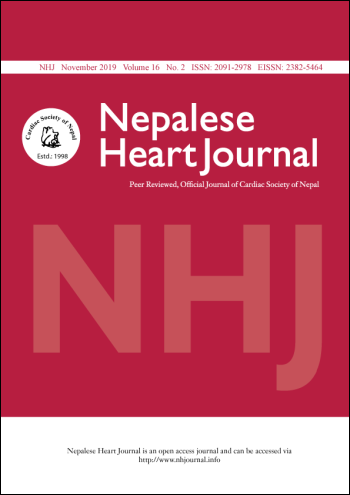Cardiac Resynchronization Therapy- Single center experience in Nepal
DOI:
https://doi.org/10.3126/njh.v16i2.26308Keywords:
Biventricular pacing, Cardiac resyncghronization therapy, Coronary sinus, heart failureAbstract
Background and Aims: Cardiac resynchronization therapy (CRT) has become an established treatment modality for patients with advanced heart failure. CRT abbreviates the dysynchronus heart failure mainly by correcting left ventricular dysynchrony. In the last three years, CRT has been regularly done in Shahid Gangalal National Heart Center(SGNHC) which has provided us the platform to report the outcome of CRT, for the first time in Nepal. The aim of this study is to review the recent clinical experience and outcome of CRT in our centre.
Methods: All consecutive patients who underwent CRT at SGNHC from July, 2016 to July, 2019 were reviewed retrospectively.
Results: Altogether 42 patients underwent CRT. Mean age was 65±11 years (range 43 to 84). Coronary sinus cannulation was successful in 41 patients. In one patient, LV lead delivery was unsuccessful. Thus, procedural success was obtained in 95% (40 out of 42) patients. LV lead dislodgement occurred in three patients (7%). Coronary sinus dissection occurred in two patients (5%). Biventricular (BiV) paced QRS was significantly narrower compared to baseline QRS (127ms Vs 162ms, p<0.01). During mean follow up of 12±10 months (range 1 to 30 months), there was significant improvement in the clinical outcomes: NYHA class (1.8 Vs 2.9, p<0.01), LVEF (22.3 Vs 27.5, p<0.01), left ventricle internal diameter in systole (LVIDs), (57 Vs 60.5 mm, p<0.01). The CRT responder rate was 86%. Super-responder was observed in 12% of patients.
Conclusion: In SGNHC, Cardiac resynchronization therapy is emerging as a routine treatment strategy with a reasonable efficacy and safety outcome.
Downloads
Downloads
Published
How to Cite
Issue
Section
License
This license enables reusers to distribute, remix, adapt, and build upon the material in any medium or format, so long as attribution is given to the creator. The license allows for commercial use.




